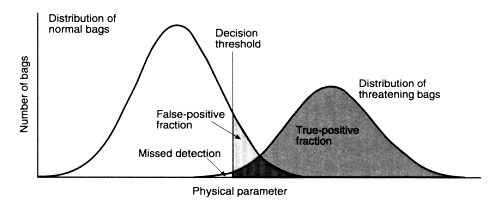Appendix C Threat-Decision Paradigm
A straightforward paradigm from statistical decision-making theory can be used as the framework for a task-based means of evaluating the performance of image-based explosives-detection equipment, such as the InVision CTX-5000. This paradigm can also be used to explain, conceptually, the classification of an explosive threat by other explosives-detection technologies. To assess explosives-detection equipment with this paradigm, a task must be specified (e.g., detection of an explosive threat), and then the ability of the equipment to perform the task must be determined.
Explosives-detection equipment use qualitative and quantitative information extracted from objects within baggage to determine (classify) the presence of an explosive threat. If the information extracted was combined to represent a single physical parameter, the physical parameter can be thought of as a decision variable. The paradigm presupposes a population of explosive threat and normal bags that generates a position and spread (or distribution) of the physical parameter for each population. The overlap of the two populations determines the performance of the equipment. To classify the information obtained from the equipment, a threshold value of the physical parameter is adopted on which to base a decision on the presence of an explosive threat. The threshold value of this physical parameter establishes the detection (true-positive fraction) and false-alarm (false-positive fraction) rates (see Figure C-l). The primary focus of a test and evaluation plan should be those aspects of the explosives-detection equipment that affect the value of the physical parameters that establish the decision threshold.
There are several factors that may contribute to the position and breadth of the distribution of a physical parameter, ultimately determining a detection and false-alarm rate. These contributors include random fluctuations due to statistical processes inherent to data acquisition (e.g., x-ray photon statistics), artificial clutter (noise) resulting from the type and orientation of objects within baggage (e.g., streaks from high atomic number materials in a computed tomography image), mechanical drifts (e.g., bag positioning, resolution degradation), physical and electronics drifts in the x-ray detection and data-acquisition systems, and variation (noise) from different objects within the bag (e.g., clothing, food items, hairdryers) and different types of bags (e.g., nylon, leather, large, small). An estimate of the magnitude of the major contributions to the spread in a physical parameter can be obtained by accessing information at different stages of the explosives-detection process.

Figure C-1
Schematic drawing of the statistical decision theory paradigm.
Note: This is not representative of the true distribution of threat-containing and nonthreat-containing baggage.

